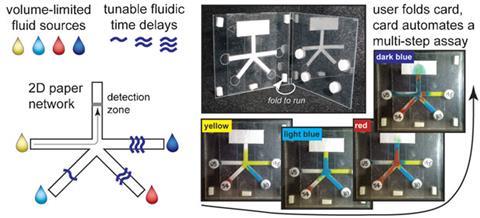Researchers in the US have demonstrated that the speed of fluid in a paper microfluidic device can be controlled by sugar solutions dried onto the paper.
Many chemical tests require washing steps and the addition of reagents in a precisely timed sequence. These steps can be controlled manually, but if they are automated there is less room for human error.
The use of microfluidics to miniaturise assays is now common. However, a simple method for automated sequential reagent addition has yet to be perfected for paper devices. Current methods for creating delays involve redesigning the geometry of the device and the length of incoming channels every time a new test with different fluids is needed. Now, Barry Lutz and colleagues, at the University of Washington, in Seattle, have had the resourceful idea of using sugar to slow down the flow of liquid.
The team created the so-called sugar delays by dissolving sugar at different concentrations and drying it onto paper strips. ‘Sugar delays allow a paper shape to be “programmed” based on the concentration of sugar applied to each leg,’ explains Lutz. The sugar holds back the flow of fluid by anything from a few minutes to an hour. Reagents and buffer salts can be pre-deposited dry and then no further pipetting steps are necessary. Unmeasured amounts of sample and water can be added to the paper and the sugar will make sure that only the right volumes reach the detection zone.

This simple automation of multi-step reactions in a paper-based device is a step toward practical and cheap point-of-care immunoassays. The team are now busy creating a whole toolbox of mechanisms along the same lines for flow timing and switching in paper devices. ‘Using paper devices in a point-of-care format could provide earlier diagnosis of diseases such as malaria, dengue fever and HIV, where sensitivity is very important,’ Lutz adds.






No comments yet